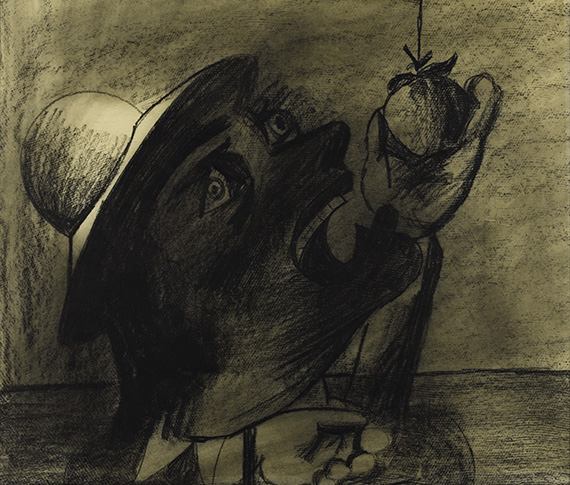
Significant funds raised during the QAGOMA Foundation’s Annual Dinner in 2014 enabled conservators to examine some of Charles Blackman’s works on paper. Two charcoal drawings, in particular, illustrate his dynamic talent.
Australian modernist painter Charles Blackman’s formative relationships with Queensland artists and writers were pivotal in his development as one of the country’s most prolific artists. Although primarily known for his painting, his charcoal drawings captured vivid imagery and were fundamental to his initial recognition.1
Blackman is considered a self-taught artist, although during 1942–45 he attended drawing classes at East Sydney Technical School, and later, life-drawing classes at the Sketch Club in Haymarket, Sydney, where his drawing style was described as, ‘if he were the other half of the duel and the paper had a rapier of its own’.2 When asked about his preference for graphic techniques, Blackman replied ‘I draw. That is what I love most of all. My interest in graphics has been through other people’s persuasion, to be frank’.3 He taught himself by observing other people’s works, including the imaginative illustrations of Odilon Redon.

Redon’s influence can be seen in the combination of dream and reality in Blackman’s ‘schoolgirl’ drawings.4 In Playground at night c.1952, an enormous upturned schoolgirl’s head blocks the path of two frightened girls, whose distress is captured in their scrawled, agitated forms. Evocative and economical in his use of line to convey emotion, Blackman attacks the paper, creating the giant, menacing schoolgirl whose contorted body merges with the shadows in the foreground.
Blackman has used both compressed charcoal 5 and wax crayon to heighten the work’s internal tension. Compressed charcoal is charred wood dust with a gum binder and is comparatively darker than vine charcoal. It is harder to erase and harder to smudge, but makes a darker mark. The medium comes in a range of formats: from pastel sticks, which Blackman has used here where the line is broad; to wooden pencils, which, due to the high portion of binder, results in a firmer core with a narrower, finer line. With it, he created the windows in this isolated streetscape, while the facial features of the threateningly large head, specifically the intimidating black pupils, were made using a heavy black wax crayon.
Felicity St John Moore has written that, ‘for Blackman as well as Redon, black was the essential colour of the mind’.6 This haunting image, reminiscent of the deserted urban landscapes of Giorgio de Chirico, also points to Blackman’s familiarity with the surrealists from his hours in the Carnegie Art Library.7 Brian Finemore praised him for his surrealist abilities:
By isolation, by concentration, by eliminating detail, by reducing the tonal range he intensifies a pictorial effect which compels us to look afresh . . . to become involved with the lost.8

Untitled (schoolgirl craving for an apple) c.1951–53 presents a primal figure, its mask-like face revealing rather than concealing its emotion. In an interview with Thomas Shapcott, Blackman described his subject: ‘My schoolgirls wear bullet-proof vests. Their skirts are parachutes of sex. Under their mushroom hats, their eyes are laced with black laces’.9 Here, Blackman has captured the anxious anticipation of ‘the bite’, while the heavy application of charcoal over the entire surface of this work forms an almost impenetrable shadow.
Blackman used rolled architectural detail paper for both of these drawings. When speaking with Thomas Shapcott, Blackman explained why he switched to rolls of paper, stating that ‘The basic thing was portability, no weight’.10 Although detail paper is smooth, he used a frottage technique to create rough, grainy background textures. From the French frotter, ‘to rub’, the technique was initially exploited by Max Ernst and then developed further by the surrealist artists, who would ‘lift’ textures onto the paper from beneath, with the texture of a wooden floor, string or leaves being transferred by the pressure of the drawing medium. In this case, the texture was most likely formed by rough cardboard.11
Throughout his career, Blackman gained expertise in many media through his drawing practice. From these two drawings alone, it is possible to appreciate his brilliance.
Endnotes
1 Felicity St John Moore, Charles Blackman: Schoolgirls and Angels – A Retrospective Exhibition of Paintings and Drawings by Charles Blackman [exhibition catalogue], National Gallery of Victoria, Melbourne, 1993, p.35.
2 Moore, p.15.
3 James Gleeson interview with Charles Blackman [transcript], 26 April 1979, James Gleeson Oral History Collection, National Gallery of Australia, Canberra, 1979, p.11.
4 Moore, p.1.
5 In his interview with James Gleeson, Blackman states: ‘The medium that I always use when I say “crayon”, is actually compressed charcoal. I always use the one thing. When I say “crayon” I am not being accurate. It should be ‘compressed charcoal’ all the way through unless charcoal is specified’, p.16.
6 Moore, p.2.
7 Moore, p.16.
8 Brian Finemore, National Gallery of Victoria Annual Bulletin, 1961, p.23. Cited in Moore, p.58.
9 Thomas Shapcott, 1966. Cited in Moore, p.44.
10 Thomas Shapcott, The Art of Charles Blackman, Andre Deutch, London, 1989, p.18.
11 Blackman was purchasing cardboard to paint on during this period, as he recounts in his interview with James Gleeson. ‘Also, I had a bit more money because I had sold a picture. I actually had twenty pounds. So I went to a place and bought 50 sheets of cardboard . . . it would have been 1952’, p.13.
Subscribe to YouTube to watch behind-the-scenes footage and exclusive interviews / Read more on our blog
Samantha Shellard is Conservator, Works on Paper, QAGOMA

